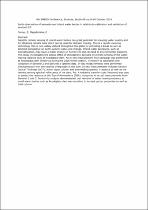 ResearchSpace
ResearchSpace
Earth observation of aerosols over inland water bodies in relation to calibration and validation of sentinel 2/3
JavaScript is disabled for your browser. Some features of this site may not work without it.
- ResearchSpace
- →
- Research Publications/Outputs
- →
- Conference Publications
- →
- View Item
| dc.contributor.author |
Faniso, Zimbini

|
|
| dc.contributor.author |
Magidimisha, Edwin

|
|
| dc.date.accessioned | 2019-04-11T06:45:02Z | |
| dc.date.available | 2019-04-11T06:45:02Z | |
| dc.date.issued | 2018-10 | |
| dc.identifier.citation | Faniso, Z, and Magidimisha, E. 2018. Earth observation of aerosols over inland water bodies in relation to calibration and validation of sentinel 2/3. 5th SMEOS Conference, Skukuza, South Africa, 8-10 October 2018, 7pp. | en_US |
| dc.identifier.uri | https://www.spiedigitallibrary.org/conference-proceedings-of-spie/11043/110430U/Earth-observation-of-aerosols-over-inland-water-bodies-in-relation/10.1117/12.2502492.full?SSO=1 | |
| dc.identifier.uri | http://hdl.handle.net/10204/10950 | |
| dc.description | Copyright: 2018 SPIE. Due to copyright restrictions, the attached PDF file only contains the abstract of the full text item. For access to the full text item, kindly consult the publisher's website. | en_US |
| dc.description.abstract | Satellite remote sensing of inland water bodies has great potential for ensuring water quality and for obtaining reliable data which can be used for decision making. This is a rapidly evolving technology that is now widely utilized throughout the globe for providing a broad as well as detailed perspective on earth-system status and change. Inland water processes, such as eutrophication, may have a major impact on human life and can lead to environmental disasters. This study investigates the optical effect of atmospheric aerosols on remote sensing of the water-leaving radiance (Lw) at Roodeplaat dam. An in-situ measurement field campaign was performed at Roodeplaat dam (Pretoria) during the 2016 winter season, in relation to calibration and validation of Sentinel 2 and Sentinel 3 satellite data. In-situ measurements were performed simultaneously with the satellite overpasses at the dam. In-situ measurements included Aerosol Optical Thickness (AOT), water vapor column and downwelling spectral irradiance as well as the remote sensing spectral reflectance of the dam, Rrs. A radiative transfer code (Modtran) was used to predict the radiance at the Top of Atmosphere (TOA), compared to actual measurements from Sentinel 2 and 3. Sensitivity analysis demonstrated that retrieval of water-leaving radiance at small water bodies such as Roodeplaat dam was sensitive to aerosol optical properties as well as total column. | en_US |
| dc.language.iso | en | en_US |
| dc.publisher | SPIE | en_US |
| dc.relation.ispartofseries | Worklist;22184 | |
| dc.subject | Aerosols | en_US |
| dc.subject | Inland water bodies | en_US |
| dc.subject | Radiative transfer models | en_US |
| dc.subject | Satellite remote sensing | en_US |
| dc.title | Earth observation of aerosols over inland water bodies in relation to calibration and validation of sentinel 2/3 | en_US |
| dc.type | Conference Presentation | en_US |
| dc.identifier.apacitation | Faniso, Z., & Magidimisha, E. (2018). Earth observation of aerosols over inland water bodies in relation to calibration and validation of sentinel 2/3. SPIE. http://hdl.handle.net/10204/10950 | en_ZA |
| dc.identifier.chicagocitation | Faniso, Zimbini, and Edwin Magidimisha. "Earth observation of aerosols over inland water bodies in relation to calibration and validation of sentinel 2/3." (2018): http://hdl.handle.net/10204/10950 | en_ZA |
| dc.identifier.vancouvercitation | Faniso Z, Magidimisha E, Earth observation of aerosols over inland water bodies in relation to calibration and validation of sentinel 2/3; SPIE; 2018. http://hdl.handle.net/10204/10950 . | en_ZA |
| dc.identifier.ris | TY - Conference Presentation AU - Faniso, Zimbini AU - Magidimisha, Edwin AB - Satellite remote sensing of inland water bodies has great potential for ensuring water quality and for obtaining reliable data which can be used for decision making. This is a rapidly evolving technology that is now widely utilized throughout the globe for providing a broad as well as detailed perspective on earth-system status and change. Inland water processes, such as eutrophication, may have a major impact on human life and can lead to environmental disasters. This study investigates the optical effect of atmospheric aerosols on remote sensing of the water-leaving radiance (Lw) at Roodeplaat dam. An in-situ measurement field campaign was performed at Roodeplaat dam (Pretoria) during the 2016 winter season, in relation to calibration and validation of Sentinel 2 and Sentinel 3 satellite data. In-situ measurements were performed simultaneously with the satellite overpasses at the dam. In-situ measurements included Aerosol Optical Thickness (AOT), water vapor column and downwelling spectral irradiance as well as the remote sensing spectral reflectance of the dam, Rrs. A radiative transfer code (Modtran) was used to predict the radiance at the Top of Atmosphere (TOA), compared to actual measurements from Sentinel 2 and 3. Sensitivity analysis demonstrated that retrieval of water-leaving radiance at small water bodies such as Roodeplaat dam was sensitive to aerosol optical properties as well as total column. DA - 2018-10 DB - ResearchSpace DP - CSIR KW - Aerosols KW - Inland water bodies KW - Radiative transfer models KW - Satellite remote sensing LK - https://researchspace.csir.co.za PY - 2018 T1 - Earth observation of aerosols over inland water bodies in relation to calibration and validation of sentinel 2/3 TI - Earth observation of aerosols over inland water bodies in relation to calibration and validation of sentinel 2/3 UR - http://hdl.handle.net/10204/10950 ER - | en_ZA |





